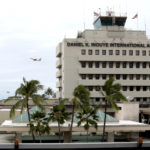Daniel K. Inouye International Airport (HNL) achieved Airport Carbon Accreditation (ACA) Level 3 status from the Airports Council International.
This recognition by the ACA, which is the global benchmark for carbon management in the airport industry, underscores HDOT’s commitment to reduce the airport’s carbon footprint by significantly reducing fossil fuel use in vehicles, generating clean renewable energy, and optimizing operations for energy efficiency.
The airport accomplished four important steps that include:
- Setting a goal to reduce airport-controlled carbon emissions by 50% by 2030 and net-zero airport-controlled carbon emissions by 2045. This aligns with the state of Hawai‘i HRS §225P-5: Zero Emissions Clean Economy Target (2018, 2022).
- Engaging more than 29 operational stakeholders on their sustainability plans and explored ways to support.
- Took inventory of non-airport-controlled carbon emissions sources, including flights and ground transportation, to get a better understanding of carbon emissions overall.
- Set strategies for emissions reductions prioritized by ease of implementation and guided by values in the Hawai‘i Pathways to Decarbonization report (DBEDT 2023).
In 2016, HNL became one of the first 10 airports in North America to achieve ACA Level 1 (Mapping). In 2017, the airport reached ACA Level 2 (Reduction), demonstrating a 46% reduction in carbon emissions from 2009 levels. Since then, HNL has consistently renewed its accreditation by refining its practices and implementing innovative strategies to reduce emissions airport-wide.
The Hawaiʻi Department of Transportation plans to expand Airport Carbon Accreditation to neighbor island airports.
AP Photo
